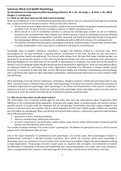Samenvatting
Summary Work and Health Psychology
- Instelling
- Tilburg University (UVT)
Summary of the chapters: 1, 3, 4, 5, 6, 7, 8, 10, 11, 12, 13, 14, 15, 16 & 19 from An Introduction to Contemporary Work Psychology (Peeters, de Jonge & Taris)
[Meer zien]














